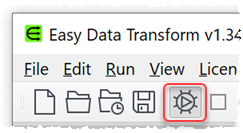A Universally Unique Identifier (UUID) is used to uniquely identify objects in computer systems. It is also known as a Globally Unique Identifier (GUID). A UUID can be added to each row of a datset, to uniquely identify that row.
The standard format of a UUID is a randomly generated 32-hexadecimal character string, formatted as 8-4-4-4-12, often with curly braces:
{xxxxxxxx-xxxx-xxxx-xxxx-xxxxxxxxxxxx}
Where each x is a hexidecimal digit (0-9,a-f).
For example:
{8ac56c2f-76d8-4725-b0a2-93641c4d3e08}
Certain bits can be set to show which version and variant of UUID it is. The above conforms to {xxxxxxxx-xxxx-4xxx-yxxx-xxxxxxxxxxxx}, so it is version 4, variant b, of the UUID standard.
In theory, it is possible to generate the same UUID twice. In practice, it is so unlikely as to be not worth worrying about. You are more likely to hit by a meteorite on your way to collect your lottery winnings.
Easy Data Transform can add a column of generated UUIDs to Excel, CSV and other format files in a few clicks:
-
Download and install Easy Data Transform on your PC or Mac, if you haven’t done so already. It will only take a minute. There is a fully functional free trial and you don’t have to give us your email or sign up to anything.
-
Start Easy Data Transform. Make sure the Auto Run button is pressed in.

- Drag the data file you wish to generate the UUIDs for, onto Easy Data Transform. An input item will be added to the Center pane.

- Ensure Show advanced is checked in the Left pane.

- With the input item selected, scroll to the bottom of the transforms and click the UUID transform button.

- A UUID transform item should appear in the Center pane and a new column of generated UUIDs will be added to the dataset.

-
In the right pane, you can choose if you want the UUID to include braces and hyphens. You can also change the new column name.
-
To output the new dataset, with generated UUIDs, select the UUID transform item in the Center pane and click the To File button near the bottom of the left pane. You can output to various formats, including Excel, CSV, JSON and XML.

-
A new set of UUIDs will be generated each time the transform is run (e.g. if the input data changes).
-
File>Save this .transform file, if you want to use it again.
Easy Data Transform can easily handle datasets with millions of rows and thousands of columns.
See the video above for more details.
As well as generating UUIDs, Easy Data Transform can help with cleaning, filtering, blending and analysing your data. All without coding. Download the free trial for Windows or Mac and try it yourself.
 Windows Download
Windows Download
 Mac Download
Mac Download